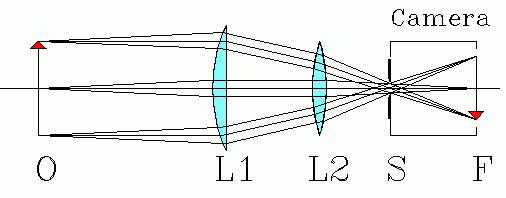Telecentric Lens Systems

Here's a ray diagram of a commercial telecentric lens system. The object is at O, the image at I. The photographic film, or other image sensor, is placed at I. A "stop" or aperture is at S to block all rays except those in a narrow bundle. This serves not only as an aperture stop, controlling the amount of light that reaches the film, but is also strategically located at the focal point of the front and rear lens elements.
There's an optimum location for both object and film for best image sharpness. If the object is moved nearer or farther from the lens system, it's size on the film doesn't change. The quality of focus does change, but if the stop S is made very small, this can be minimized.
A telecentric lens "sees" a cylindrical tube of space of diameter equal to that of the front lens element. It is limited to photographing objects whose lateral dimensions do not exceed the diameter of the lens. The subject (object) is rendered on the film isometrically, such that equal distances, whatever their orientation, are equal distances on the film. Parallel lines of the subject are parallel on the film. A slight readjustment of lens elements can result in an "pericentric" lens in which parallel lines converge, but in a sense opposite to that of normal photographic perspective. The pericentric picture renders more distant objects larger than nearer ones! It even allows imaging front and sides of a solid object all in one picture.
The system above is telecentric in both image and object space. Moving the object or film relative to the lens results in no change of image size. The picture on my illusions page was made with a much simpler system that is telecentric only in object space. The lenses were simple and non-achromatic, simply lenses that happened to be available.

It consisted of two positive lenses, L1 and L2, and a digital camera. The camera lens is at S, and is not explicitly shown. In fact, all that's really necessary at plane S is a small aperture stop to limit rays to narrow bundles. If you can obtain a large diameter lens, you only need lens L1. The extra lens L2 serves only to present to the camera a larger angle of view. Since this camera's own lens wasn't removable, a 2-diopter` (50 cm focal length) negative lens was placed closely in front of it to provide a larger working distance between L1 and the object, O. In this diagram, F labels the film plane of the camera. If only one lens, L1, is used, it is located so that its focal point is at the diaphragm stop S.
The camera is moved forward or back with respect to the positive lens(es) until telecentric conditions are obtained (the object size seen by the camera is independent of subject position). Then the object is placed at the position of best focus.
 |
| Illusion picture made with a digital camera and a telecentric lens system. |
|---|
1. The Advantages of Telecentricity. Edmund Optics.
2. Telecentric lenses tutorial. Opto Engineering.
3. Telecentric Lens Systems. A laboratory experiment.
Return to Visual Illusions.
Return to Donald Simanek's page.